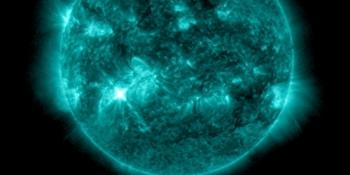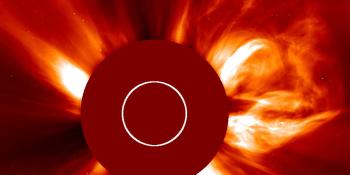Przeglądasz Archiwum z środa, 18 czerwca 2003
Raport aktywności słonecznej
Każdy wspomniany rozbłysk słoneczny w tym raporcie ma współczynnik skalowania dodany przez Space Weather Prediction Center (SWPC). Przez skale współczynników SWPC, raporty o rozbłyskach słonecznych są o 42% mniejsze niż naukowo jakościowa data. Skale współczynników zostały usunięte z naszych archiwów o rozbłyskach słonecznych by odzwierciedlić prawdziwe jednostki fizyczne.
Raport aktywności słoneczno- geomagnetycznej 2003 Jun 18 2200 UTC
Przygotowane przez NOAA © SWPC i przetworzone przez SpaceWeatherLive.comPołączenie raportów USAF/NOAA o słonecznej i geofizycznej aktywności
Numer SDF 169 wydany w 2200Z na 18 Jun 2003
IA. Analiza aktywności regionów słonecznych i aktywność od 17-2100Z do 18-2100Z
Solar activity increased to high levels today. Region
386 (S07E43) produced an M6.8 x-ray flare (correlated using SXI
imagery) at 17/2255Z that had an associated Tenflare (2100 sfu),
Type IV and Type II radio sweeps (an estimated shock velocity of 1000
km/sec). This region showed growth in the magnetic structure
surrounding the dominant lead spot as a delta complex has become
evident since yesterday. The penumbral field coverage has changed
little over the period. Newly numbered Region 387 (N18E62) produced
several minor flares during the interval.
IB. Prognoza aktywności słonecznej
Solar activity is expected to be at
moderate to high levels. Region 386 has the potential to produce an
isolated major flare.
IIA. Podsumowanie aktywności geofizycznej 17-2100Z do 18-2100Z
The geomagnetic field was at predominantly minor to major storm
levels with an isolated period of severe storm conditions seen at
high latitudes between 18/0600 and 0900Z. A co-rotating integrated
region preceding a recurrent high speed coronal hole stream and is
believed to responsible for the storm conditions. The greater than
10 Mev proton flux at geosynchronous orbit reached event threshold
at 18/2050Z and due to the recent activity the exact source for this
particle event is not certain.
IIB. Prognoza aktywności geofizycznej
The geomagnetic field is
expected to be at predominantly active to minor storm levels due to
a recurrent high speed coronal hole stream. Isolated major storm
conditions are possible on day one due to the potential for
transient activity. The greater than 10 MeV proton event should
remain above threshold level through the first day of the interval.
III. Prawdopodobieństwa zdarzenia 19 Jun do 21 Jun
| Klasa M | 60% | 60% | 60% |
| Klasa X | 20% | 20% | 20% |
| Proton | 99% | 50% | 25% |
| PCAF | in progress
|
IV. Przepływ 10,7 cm z Penticton
Zaobserwowano 18 Jun 120
Przewidywane 19 Jun-21 Jun 120/120/120
Średnia z 90 dni 18 Jun 125
V. Indeks geomagnetyczny A
Zaobserwowano Afr/Ap 17 Jun 030/050
Szacowane Afr/Ap 18 Jun 035/050
Przewidywane Afr/Ap 19 Jun-21 Jun 025/035-020/025-020/025
VI. Prawdopodobieństwa aktywności geomagnetycznej 19 Jun do 21 Jun
| A. Średnie szerokości geograficzne |
|---|
| Aktywne | 40% | 50% | 50% |
| Słaba burza | 30% | 20% | 20% |
| Bardzo znacząca burza | 15% | 05% | 05% |
| B. Wysokie szerokości geograficzne |
|---|
| Aktywne | 40% | 50% | 50% |
| Słaba burza | 40% | 30% | 30% |
| Bardzo znacząca burza | 20% | 10% | 10% |
VII.
PLAIN
To ensure continued operational monitoring of important energetic particle data, it is necessary to reassign primary/secondary designations for the GOES Space Environment Monitor (SEM) detectors. GOES 11 (113W) will become the primary satellite for protons. The transition from GOES 8 to GOES 11 was scheduled for 18 June, but has been delayed until 19 June. GOES 12 will continue as the primary satellite for magnetometer, X-ray, and electron measurements. GOES 10 (135W) will be the secondary satellite for all SEM sensors - magnetometer, X-ray, and energetic particles. Because of the degraded state of the proton data on GOES-10, its designation as the secondary source for proton data is a short-term solution. More permanent solutions have been identified and are being evaluated. Users will be notified when we define and schedule a permanent fix. Further details can be
found at http://www.sec.noaa.gov/GOES.html.
MAGNETOMETER
On 16 June, it was determined that a scaling problem exists with the Boulder magnetometer instrument. While this problem, and its fix are being investigated the primary instrument for Boulder K-indices has been switched to the Boulder USGS (via Domsat) magnetometer, effective 1500 UTC on 16 June.
Wszystkie czasy w UTC
<< Idź do codziennego przeglądu



